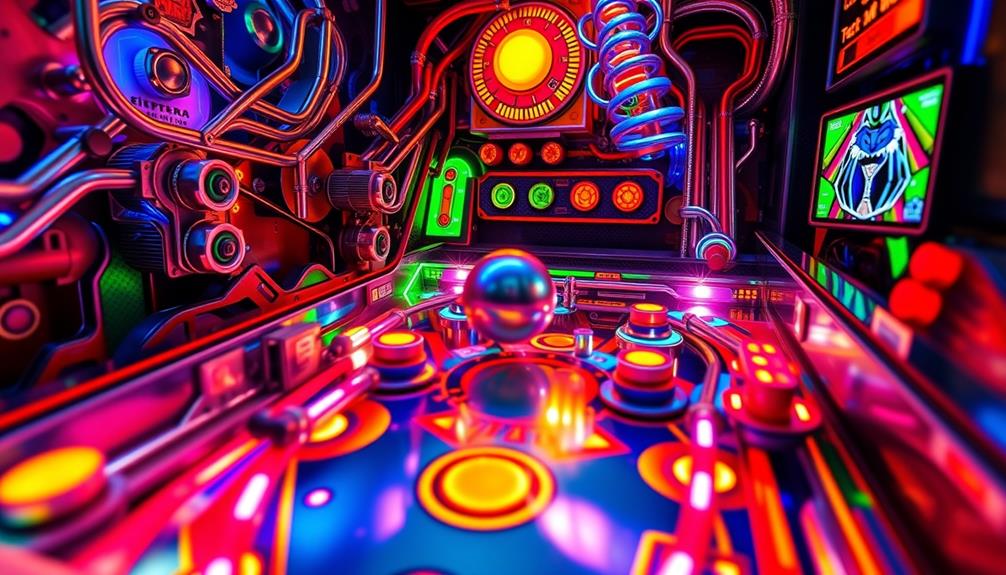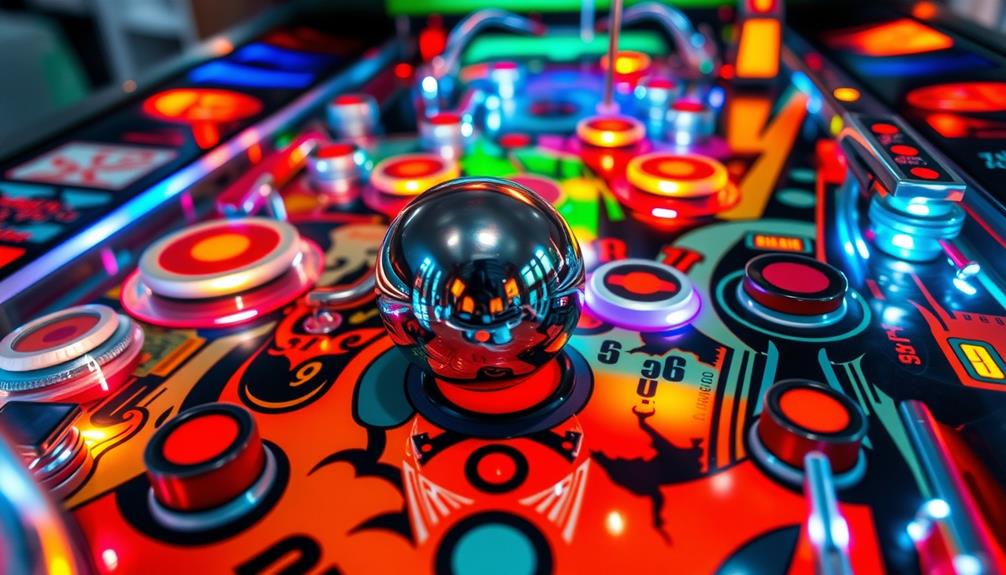Pinball machines combine mechanical and electronic components to deliver an exhilarating experience. Players launch a ball using a plunger and guide it with flippers at the bottom of the playfield. The playfield is angled and includes bumpers, ramps, and targets to enhance gameplay. Points are earned by hitting these elements, with scores displayed on a dot matrix screen. If the machine is shaken excessively, the tilt mechanism activates to ensure fair play. Thanks to advancements like microprocessors and real-time scoring, modern pinball machines are more dynamic than ever. Stay tuned to discover more thrilling features of pinball machines!
Key Takeaways
- Pinball machines use a tilted playfield with obstacles, flippers, and targets to create dynamic gameplay and scoring opportunities.
- The ball is launched using a plunger mechanism, and players control its direction with flippers at the bottom.
- Scoring is achieved by hitting targets and ramps, with combination shots potentially triggering jackpots or bonuses.
- A tilt mechanism prevents excessive shaking, maintaining fair play by stopping the game if manipulated.
- Modern machines feature microprocessors, allowing real-time scoring updates and interactive gameplay experiences.
Pinball Machine Overview
Pinball machines are fascinating gaming devices that combine mechanical and electronic elements to create an engaging experience. At the heart of each machine is the playfield, an inclined surface designed at a 6-7 degree angle to enhance ball movement and gameplay dynamics.
As you play, you'll encounter various obstacles like bumpers, ramps, and targets that interact with the ball, making each game unique. The design of these machines often reflects cultural influences, similar to how astrology influences self-image and confidence.
When you insert a coin, the machine's electronic system activates, allowing you to start the game by pressing the launch button, which releases the ball. Your main goal is to keep the ball in play using the flippers located at the bottom of the playfield. These flippers are your only defense against the ball draining, and they allow you to redirect the ball to maximize your scoring.
As you hit targets and complete specific shot sequences, your points accumulate, displayed on a dot matrix display in the backbox. Modern pinball machines utilize advanced technology, featuring extensive wiring that can exceed half a mile, connecting all components for complex interactions and game features.
This blend of mechanics and technology makes playing a pinball machine a truly enthralling experience.
Key Components Explained
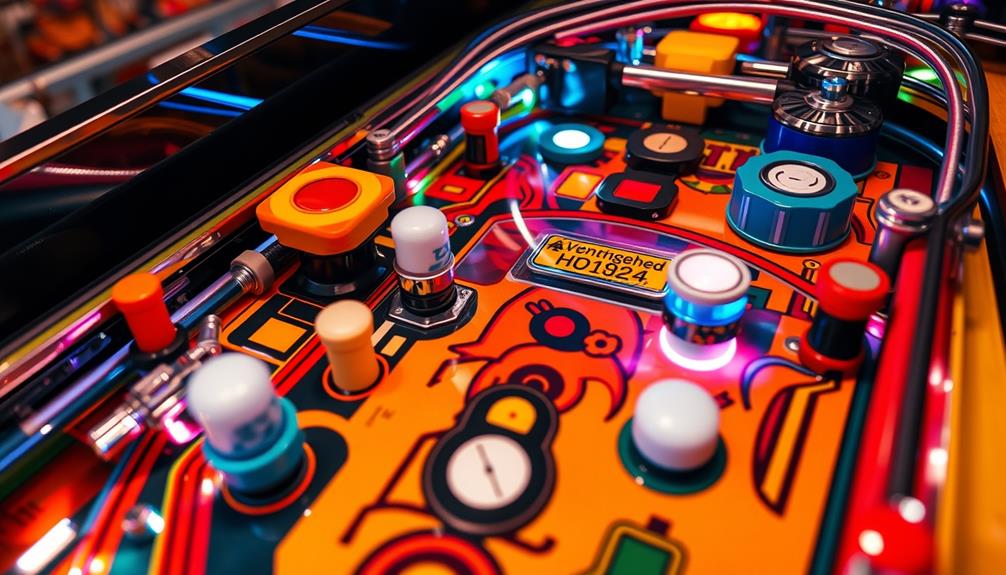
Every pinball machine features key components that work together to create the thrilling gameplay experience you enjoy. The playfield is the heart of the machine, typically made of wood and tilted at a 6-7 degree angle. This design allows the pinball to move dynamically, interacting with various obstacles like bumpers and ramps, much like how silly tantrums can add humor to shoots during family photoshoots.
You control the action using flippers, which are strategically placed at the bottom of the playfield. By pressing buttons located below the glass top, you can propel the ball and keep it in play, preventing it from draining down the sides. The challenge lies in timing your flipper movements to hit targets and score points.
Above the playfield, the backbox houses the dot-matrix display, showing your scores and providing gameplay hints. It also contains the main electronics that manage the machine's operations.
When you insert a coin, a coin acceptor signals the machine's computer, granting you credit to play. Additionally, solenoids are used to launch the ball into play from the plunger mechanism, kickstarting your thrilling pinball adventure. Understanding these components enhances your appreciation for the game!
Gameplay Mechanics
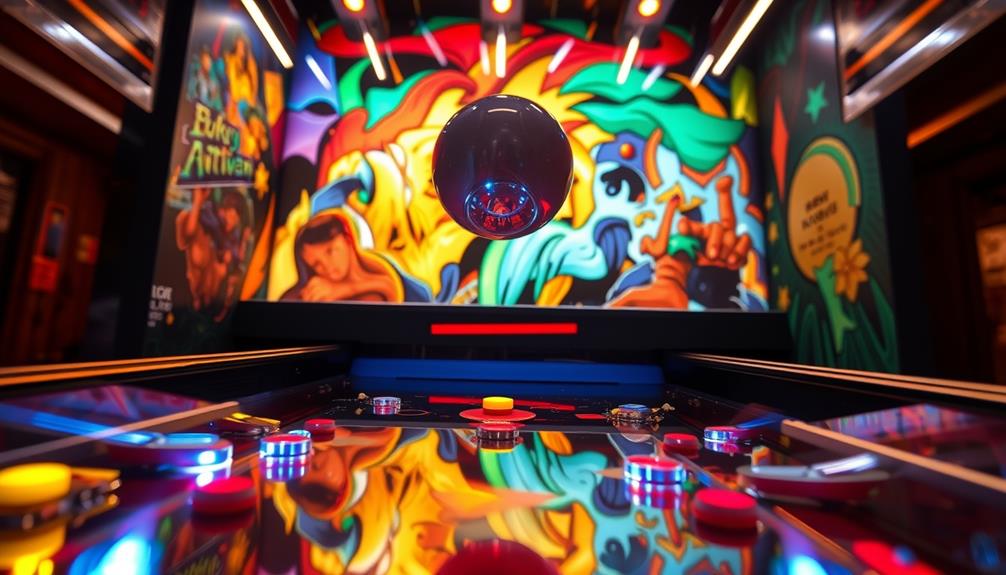
In pinball, scoring is all about hitting targets and ramps to rack up points, which you can track on the dot matrix display.
Understanding the importance of a budget can also enhance your overall gaming experience by allowing you to allocate funds wisely for play.
The tilt mechanism adds an extra layer of strategy, as excessive shaking can disrupt your game.
Plus, the playfield's angle and obstacles create dynamic interactions that keep each game feeling fresh and challenging.
Scoring Mechanisms Explained
How do scoring mechanisms in pinball machines enhance your gameplay experience? Scoring in pinball revolves around hitting targets, ramps, and bumpers that activate various scoring mechanisms. As you rack up points, your current score is displayed on a dot matrix screen, keeping you engaged and motivated.
Understanding the mechanics of scoring can be as intricate as brewing the perfect coffee, where each method affects the outcome. To maximize your points, consider executing combination shots that can trigger jackpots or bonuses. These often require hitting specific targets in a certain order, adding a layer of strategy to your gameplay.
The replay value system rewards you when you reach set point totals, allowing you to earn free games if you score in the top 10 percent. At the end of a game, the match feature generates a random two-digit number. If the last two digits of your score match this number, you snag a free game—though the odds are typically around 7% or less.
Additionally, various game modes, like Casino Frenzy, can enhance your scoring opportunities. Achieving gameplay milestones activates these modes, allowing you to rack up even more points during exciting multi-ball scenarios. With these scoring mechanisms, every play can lead to an exhilarating experience filled with potential rewards.
Tilt Mechanism Functionality
Understanding the tilt mechanism is essential for mastering pinball gameplay. This mechanism involves a metal ring and a freely hanging pendulum bob. When you shake the machine too much, the bob contacts the ring, triggering the tilt sensor. This action can lead to a standard tilt warning, which gives you two alerts before the game stops. However, if you slam the machine, the tilt sensor reacts immediately, terminating your gameplay without warning.
Effective software quality assurance practices can similarly help in maintaining a balanced and fair gaming experience.
The tilt mechanism is designed to maintain fair play, preventing you from influencing the ball's movement through aggressive actions like lifting or shaking the machine. It's important to strike a balance between aggression and caution. Even moderate shaking can trigger the tilt sensor, leading to a frustrating gameplay experience.
To avoid tilting, pay attention to the machine's feedback and adjust your strategy accordingly. Remember, mastering the tilt mechanism not only enhances your skills but also keeps the game enjoyable.
Game Dynamics and Interaction
Pinball gameplay is all about the dynamic interaction between the player and the machine, where every move you make influences the outcome. The inclined playfield, usually set at 6-7 degrees, affects how the ball moves and interacts with various targets. This intricate design enhances the user experience, making it vital for players to understand content relevance and authority in their gameplay strategies.
Your primary tools for controlling the game are the flippers at the bottom of the playfield. By skillfully timing your flips, you can redirect the ball toward scoring targets, maximizing your points.
Scoring is activated through hitting various obstacles and targets, and experienced players often use combination shots to rack up points and trigger bonuses. Keeping an eye on the dot matrix display is essential, as it shows your current score and offers gameplay hints to enhance your strategy.
The replay value system rewards you with opportunities for free games when you reach specific point totals, encouraging you to refine your skills.
Scoring Systems

Typically, scoring systems in pinball machines are designed to keep players engaged and motivated throughout their gameplay. You'll notice the current score displayed on a dot matrix screen, guiding you toward scoring opportunities. As you play, executing combination shots can activate jackpots and bonuses, providing a thrill as you chase higher points.
Many players also appreciate the importance of competitive pricing and transparent fee structures in other arenas, like precious metal investments, which can enhance their overall gaming experience.
The replay value system rewards your efforts by offering free games when you hit specific score thresholds. Only the top 10% of scores usually surpass these thresholds, making your achievements feel special. When you reach significant milestones, audio signals enhance the excitement, letting you know you're on the right track.
At the end of your game, the match feature randomly selects a two-digit number. If it matches the last two digits of your score, you could earn a free game, with a probability of about 7% or less. This adds another layer of anticipation, keeping you coming back for more.
Tilt Mechanism and Match Feature
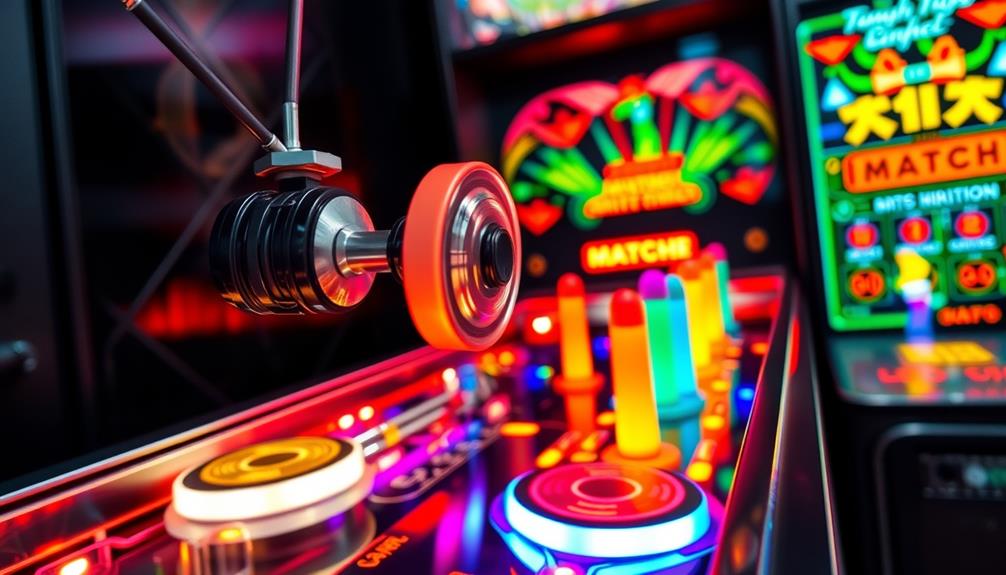
In pinball, the tilt mechanism acts as your safeguard against excessive movement, helping to keep the game fair.
It guarantees that players can't physically manipulate the machine to gain an advantage, much like a well-maintained air purifier air purifier maintenance dos and don'ts guarantees peak performance.
You'll need to learn how to manage your gameplay to avoid triggering a tilt, which can end your turn.
Meanwhile, the match feature adds a fun twist by giving you a chance to win free games, depending on how your score lines up with the randomly selected number.
Tilt Sensor Functionality
A tilt sensor mechanism is vital for maintaining fair play in pinball machines. It consists of a metal ring and a pendulum bob that hangs freely during gameplay. When you shake the machine too much, the bob touches the conductive ring, triggering the tilt sensor. This is designed for preventing players from excessively manipulating the machine to influence the ball's movement.
Emotional reflections on the impact of a mother's love can be as intense as the effects of a tilt sensor, both serving to maintain a balance in their respective domains.
When the tilt sensor activates, you'll typically receive two warnings before gameplay stops entirely. Standard tilts occur from moderate shaking, while slam tilts—resulting from extreme actions like lifting or kicking the machine—lead to immediate game termination. This strict enforcement helps guarantee that everyone plays under the same rules, preserving the integrity of the game.
If you're feeling lucky, keep in mind that the match feature comes into play after the game concludes. However, that's a topic for another time.
For now, remember that the tilt sensor mechanism is vital for a fair and enjoyable pinball experience, allowing you to focus on skill rather than trying to cheat the system. So, play smart and keep your movements controlled!
Match Feature Mechanics
At the conclusion of a pinball game, the match feature kicks in, adding an exciting twist to your gameplay experience. This feature randomly selects a two-digit number between 00 and 90, and if the last two digits of your score match this number, you score a free game!
However, the odds are low, usually around 7% or less. The thrill of chance can be likened to the unpredictability found in AI-driven storytelling techniques, enhancing engagement and excitement in various entertainment formats.
The match feature and tilt mechanism work together to create a balanced game environment. Here's how they enhance your experience:
- Luck vs. Skill: The match feature introduces an element of chance, rewarding you for your score.
- Fair Play: The tilt mechanism keeps gameplay honest by detecting excessive shaking, ensuring you can't manipulate the ball's movement.
- Warnings: Newer machines give you two warnings before triggering a tilt, allowing for strategic gameplay adjustments.
- Game Termination: Slam tilts end the game immediately, emphasizing the need for control during play.
Historical Development
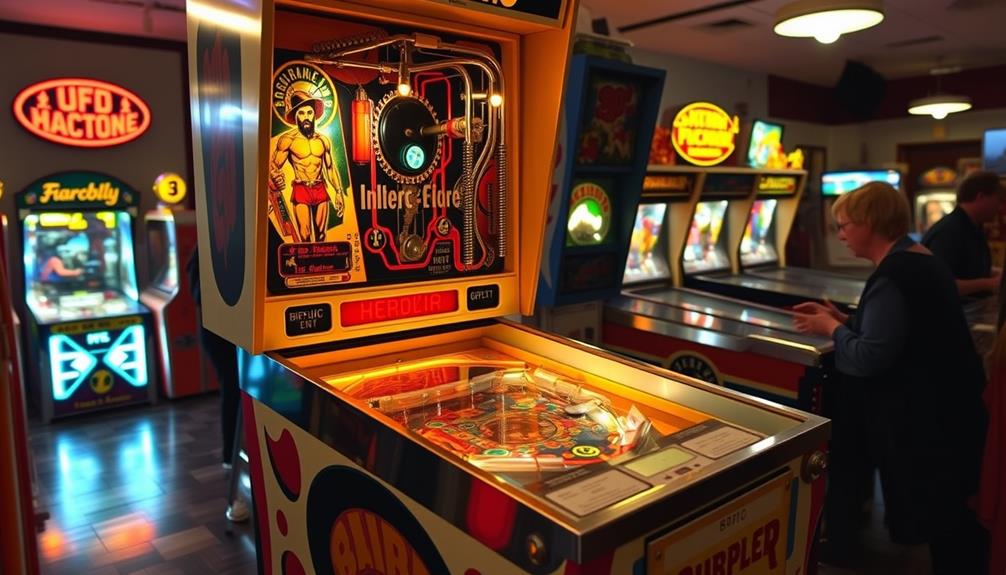
Historically, pinball machines have evolved dramatically since their inception. The journey began in 1947 with Gottlieb's release of "Humpty Dumpty," the first true pinball machine. This marked a significant development in gaming, as it introduced a more interactive experience.
The 1940s also saw the introduction of player-controlled flippers, revolutionizing gameplay. You could now influence the ball's movement more effectively, adding a new layer of strategy to the game.
As the years progressed, the 1970s brought about a major shift with the advent of microprocessors, starting with Bally's "Flicker." This innovation replaced traditional electromechanical components, allowing for more complex game mechanics and enhancing the overall gaming experience.
The 1980s witnessed a resurgence in pinball's popularity, highlighted by games like "The Addams Family," which sold over 20,000 units. This era showcased the potential for creative themes and advanced features in pinball design.
However, by the late 1990s, the industry faced a decline, leading to the closure of several major manufacturers. Despite this, Stern Pinball emerged as a dominant force, ensuring that the legacy of pinball machines continued.
Technological Innovations

You've likely noticed how pinball machines have evolved over the years, thanks to groundbreaking technological innovations.
The introduction of microprocessors not only transformed gameplay but also revamped scoring systems, making each game more engaging.
Plus, advancements in flipper mechanisms and scoring displays have taken the excitement to new heights, keeping players on the edge of their seats.
Microprocessor Advancements
Revolutionizing the world of pinball, microprocessors have transformed machines from simple mechanical devices into complex, interactive experiences. With the introduction of microprocessors, gameplay became richer, and scoring systems evolved dramatically.
The first pinball machine to utilize this technology, Bally's Flicker, emerged in 1974, paving the way for innovative designs. By 1977, Williams' Hot Tip showcased mainstream microprocessor advantages, revolutionizing the gaming landscape.
Here are four key benefits of microprocessor advancements in pinball machines:
- Complex Gameplay Mechanics: Players enjoy multi-ball play and intricate game modes that keep the action exciting.
- Real-Time Scoring Updates: Scoring is instant and dynamic, enhancing the competitive nature of the game.
- Enhanced Sound Effects: Immersive audio features add to the excitement, making each game feel unique.
- Programmable Features: Manufacturers can create engaging content that keeps players returning for more.
These advancements have notably enriched the player experience, allowing for a more interactive and enjoyable game that appeals to both casual players and pinball enthusiasts alike.
Flipper Mechanism Evolution
The evolution of the flipper mechanism has markedly shaped the way you experience pinball. It all began in 1947 with Gottlieb's "Humpty Dumpty," where flippers first allowed players to actively control the ball's movement. This innovation transformed gameplay, making it more engaging and interactive.
By 1950, the design evolved further with the introduction of "Triple Action," featuring two outward-facing flippers that added complexity and strategy to your game. The responsiveness of flippers improved considerably with the introduction of solenoids, which allowed for quicker and more precise ball control compared to earlier mechanical designs.
Fast forward to the late 1970s, manufacturers began utilizing microprocessors, enhancing the flipper mechanism's capabilities while also introducing sophisticated gameplay features. Modern pinball machines now connect flippers to a central control board, integrating them with other game components for dynamic interactions.
Today, you enjoy a level of control and gameplay experience that early players could only dream of. Each evolution in the flipper mechanism has led to a richer, more exciting pinball experience, making the journey from simple controls to advanced technology an essential part of the game's history.
Scoring System Innovations
With the advancements in flipper mechanisms enhancing gameplay, scoring systems in pinball machines have also undergone considerable transformations.
Today's scoring system leverages microprocessors to meticulously track player scores and activate a variety of interactive gameplay features, moving far beyond the basic electromechanical systems of the past.
Here are some key innovations you'll notice:
- Combination Shots: Achieving specific shot sequences can trigger jackpots and grant substantial point multipliers, boosting your player scores considerably.
- Dot Matrix Displays: These displays visually present your scores and offer gameplay hints, helping you strategize your next moves while you play.
- Replay Value: If you exceed a set point threshold, usually in the top 10% of scores, you'll receive audio alerts for free games, encouraging you to aim higher.
- Match Feature: At the end of your game, a two-digit number is randomly chosen. Match it with your final score digits for a chance to win additional plays, with a roughly 7% probability.
These innovations not only enhance the scoring system but also make the game more engaging and rewarding for players like you.
Designing Your Own Machine
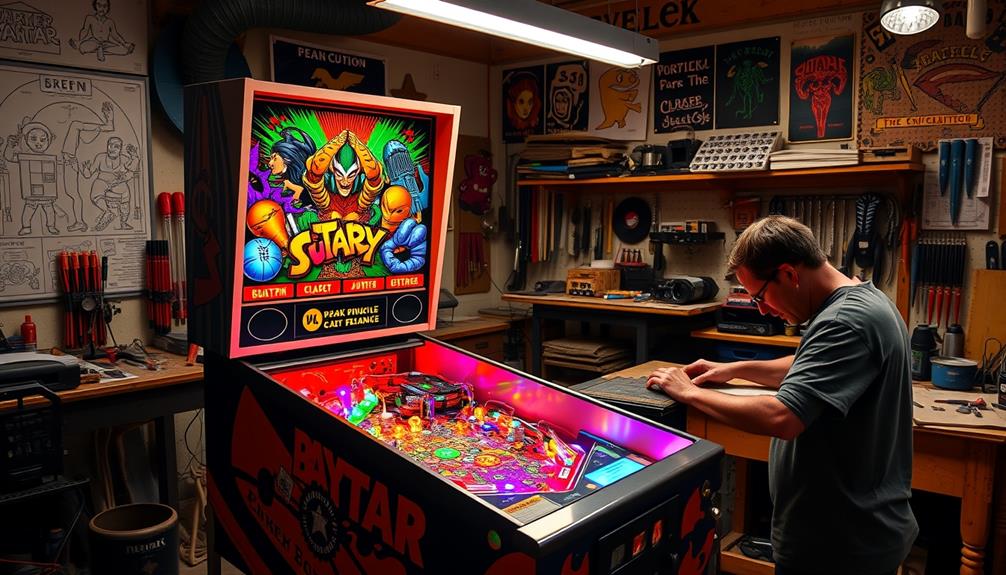
Creating your own pinball machine can be an exciting project, especially if you start with a sturdy cardboard box that serves as a solid base.
You'll want to make sure there's enough space for the playfield and all the components you plan to include. For the flippers, use lolly sticks positioned at the bottom of the playfield, allowing players to control the ball effectively during gameplay.
Next, design an engaging playfield by incorporating curves, arches, ramps, and tunnels. These elements won't only enhance the dynamics of the machine but also create a challenging experience for players.
Think about the theme you'd like to reflect in your design; vibrant artwork can make your machine visually appealing and add character.
Don't forget to experiment with the angle of the playfield. Adjusting the slope can greatly impact the marble's movement, making the game easier or more challenging based on your preferences.
Community and Collaboration
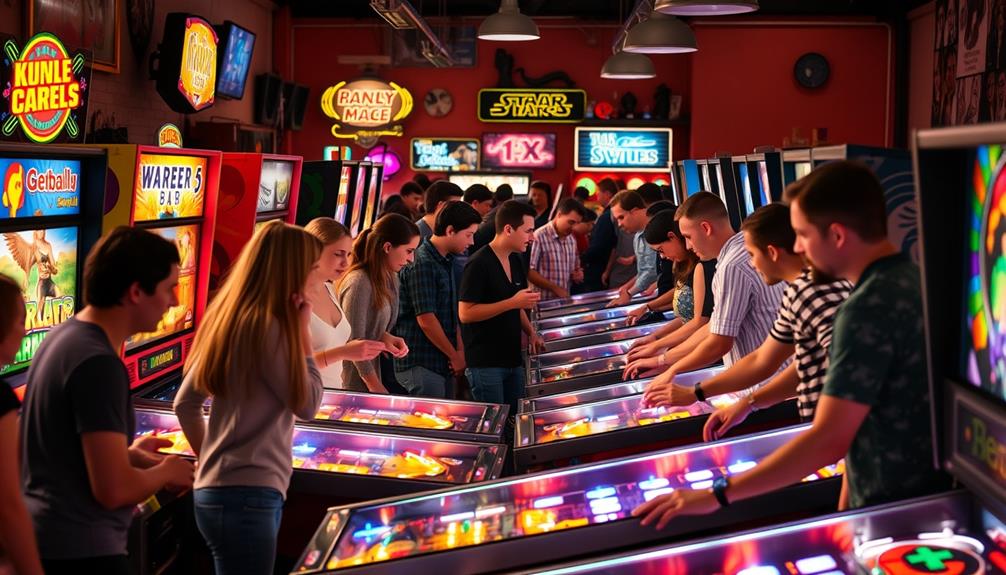
Engaging with the pinball community opens up a world of collaboration and shared knowledge. You'll find that this vibrant community thrives on contributions and the open sharing of information. By participating, you not only learn but also help others enhance their pinball experiences.
Here are some ways you can get involved:
- Online Forums: These platforms serve as a space for players and designers to discuss ideas and troubleshoot issues. You can ask questions and share your insights, enriching the collective knowledge base.
- Workshops and Meetups: Attend these events to network with fellow enthusiasts. You'll gain hands-on experience and learn innovative techniques in both design and gameplay.
- Editing Contributions: By creating an account, you can help maintain quality control in the community-driven resources. Your edits can improve the accuracy of shared information.
- Wiki Format: The adaptable nature of wikis allows for continuous updates, ensuring that the community stays relevant with new trends and technologies in pinball.
Through collaboration within this community, you'll not only improve your own skills but also contribute to a richer, more informed pinball culture.
Future Trends in Pinball
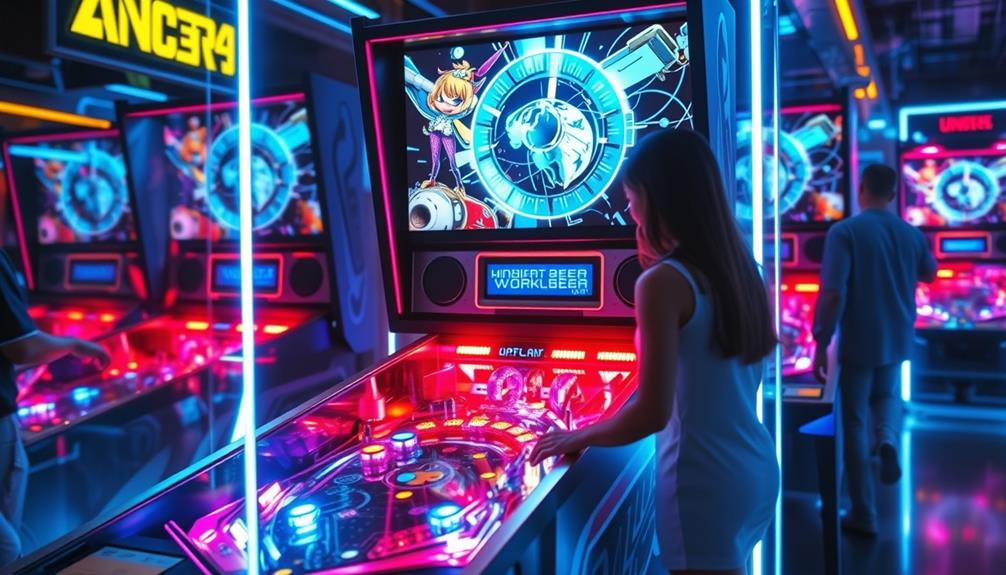
The pinball landscape is evolving rapidly, driven by a blend of nostalgia and innovation. You'll notice independent manufacturers like Jersey Jack Pinball and Spooky Pinball are at the forefront, integrating cutting-edge technology into their designs. These machines feature large color displays and advanced scoring systems that enhance gameplay, attracting both seasoned players and newcomers.
Stern Pinball continues to dominate the market, releasing several new machines each year that cater to younger demographics, particularly those aged 18 to 35. You can expect to see themes that appeal to this audience, making pinball more relevant than ever.
Additionally, the integration of virtual reality and enhanced digital features is poised to attract new players, reigniting interest in traditional machines.
The collectible market also thrives on nostalgia, with restored machines fetching impressive prices. Remakes of iconic titles are becoming popular, ensuring that classic experiences aren't lost.
As community engagement rises, you'll find online forums and workshops facilitating collaboration and innovation among enthusiasts. This trend not only fosters skill-sharing but also encourages a sense of belonging, making the future of pinball both exciting and accessible.
Frequently Asked Questions
How Does a Pinball Machine Work Step by Step?
To understand how a pinball machine works step by step, you start by inserting a coin. Then, the machine launches the ball, and you use flippers to hit targets, aiming for high scores while avoiding drains. After hitting the targets, the ball may bounce off bumpers and other obstacles, adding to the excitement of the game. The flippers, which are controlled by buttons on the sides of the machine, allow the player to keep the ball in play and strategically direct its path towards the desired targets. Understanding how pinball flippers work is key to mastering the game and achieving high scores.
What Is the Science Behind the Pinball Machine?
Oh, you thought pinball was just luck? Think again! It's all about Newton's laws, gravity, and your quick fingers. Flippers launch balls, bumpers score points, and that tilt mechanism keeps your cheating instincts in check.
How Did Old Pinball Machines Work?
Old pinball machines operated with mechanical components like bumpers and flippers. You launched the ball using a plunger, aimed for targets, and scored points through analog displays, while a tilt mechanism kept the game fair.
What Is the Trick to Pinball?
Mastering pinball's dance requires finesse. You've got to time your flipper hits perfectly, angle your shots wisely, and navigate the playfield's traps while keeping an eye on that pesky tilt. Strategy is your best friend!
Conclusion
Ultimately, understanding how pinball machines work can deepen your appreciation for this classic game. You might think it's too complicated to grasp, but once you plunge into the mechanics, you'll see it's not only fun but also intriguing. Whether you're playing or designing your own machine, the blend of skill, strategy, and technology offers endless enjoyment. So why not give it a try? You might just find yourself hooked on this enchanting pastime!
